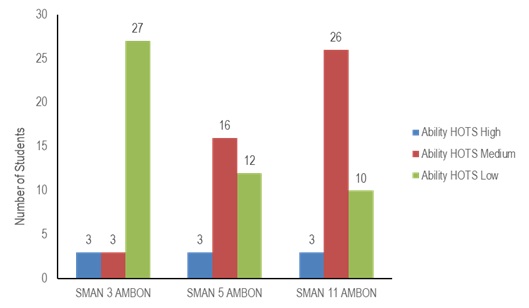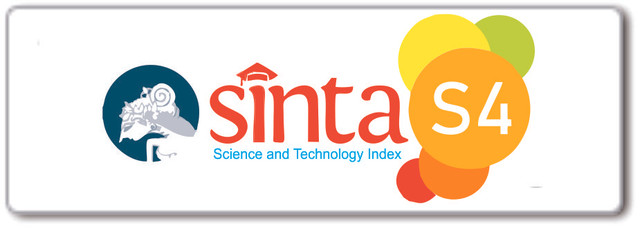Feasibility of an Instrument for Assessment of High Order Thinking Skills (HOTS) Material on Environmental Change for High School Students in Ambon City
Abstract
High Order Thinking Skills (HOTS) is interpreted as the ability to think in complex processes in decomposing material, criticizing and creating solutions to problems. The low percentage of Higher Order Thinking Skills questions in the pre-observation results is an indicator of low cognition of students in school. This study aims to determine the feasibility and effectiveness of the assessment instrument for high order thinking skills (HOTS) environmental change material in class X of high school in Ambon City. This type of research is development (R&D) with a quantitative approach designed to obtain products in the form of HOTS question measuring tools. The research population is State Senior High School 3 Ambon, State Senior High School 5 Ambon and State Senior High School 11 Ambon with a sample of 103 students. The research instruments used are HOTS test question instruments and test instrument validation sheets. The data analysis technique uses a feasibility analysis of test instruments based on HOTS questions. The results of the study show that :The HOTS question instrument for environmental change material is very feasible to be used as an assessment instrument in high schools in Ambon City. This means that the HOTS question instrument is very worthy of being given to students. HOTS-based assessment instruments on environmental change materials are effectively used as assessment instruments in high schools in Ambon City, this can be seen from the ability of students to work on question item instruments that are assessed individually. The students' scores obtained from the results of working on the test items were then averaged to obtain one score as the result of the students' HOTS thinking abilities, namely 1.27 for State Senior High School 3 Ambon, 1.71 for State Senior High School 5 Ambon, and 1.82 for State Senior High School 11 Ambon.
Downloads
References
Abosalem, Y. (2016). Assessment techniques and students’ higher-order thinking skills. International Journal of Secondary Education, 4(1), 1–11. https://doi.org/10.11648/j.ijsedu.20160401.11
Anderson, L.W., & Krathwohl, D.R (2001). A Taxonomy for Learning, Teaching, and Asssing; Arevision of Bloom’s Taxnonomy of Education Objectives. Addison Wesley Lonman Inc: New York.
Anuru, T. A., Johan, R. C., & Ali, M. (2017). Peningkatan kemampuan berpikir tingkat tinggi dalam pelajaran Ilmu Pengetahuan Alam peserta didik Sekolah Dasar melalui model pembelajaran treffinger. Eduthecnologica, 3(2), 136–144.
Apino, E., & Retnawati, H. (2017). Developing instructional design to improve ma thematical higher order thinking skills of students. Journal of Physics: Conference Series, 812(1), 012-100.
Arifin, Z., & Retnawati, H. (2017). Pengembangan instrumen pengukur higher order thinking skills matematika siswa SMA kelas X. PYTHAGORAS: Jurnal Pendidikan Matematika. https://doi.org/10.21831/pg.v12i1.14058
Budiarta, K., Harahap, M. H., Faisal, & Mailani, E. (2018). Potret implementasi pembelajaran berbasis High Order Thinking Skills (HOTS) di Sekolah Dasar Kota Medan. Jurnal Pembangunan Perkotaan, 6(2), 102–111.
Budiman, A., & Jailani, J. (2014). Pengembangan instrumen asesmen Higher Order Thinking Skill (HOTS) pada mata pelajaran Matematika SMP Kelas VIII semester 1. Jurnal Riset Pendidikan Matematika, 1(2), 139.
Hanifah, N. (2019). Pengembangan instrumen penilaian Higher Order Thinking Skill (HOTS) di Sekolah Dasar. Conference Series, 1(1), 1–8. http://ejournal.upi.edu/index.php/crecs/article/view/14286.
Istiyono, E., Mardapi, D., & Suparno, S. (2014). Pengembangan tes kemampuan berpikir tingkat tinggi Fisika (pystHOTS) peserta didik SMA. Jurnal Penelitian dan Evaluasi Pendidikan, 18(1), 1-12.
Kurniati, D. (2016). Kemampuan berpikir tingkat tinggi siswa SMP di Kabupaten Jember dalam menyelesaikan soal berstandar PISA. Penelitian dan Evaluasi Pendidikan, 20(2), 142-155.
Mardapi, D. (2008). Teknik Penyusunan Instrumen Tes dan Non Tes. Mitra Cendikia Offset: Yogyakarta.
OECD. (2018). PISA Mathematics Framework. OECD Publishing
Purbaningrum, K. A. (2017). Kemampuan berpikir tingkat tinggi siswa smp dalam pemecahan masalah matematika ditinjau dari gaya belajar. JPPM, 10(2), 40–49.
Rumahlatu, D., Sangur, K. (2019). The influence of Profect-Based Learning strategies ont the metacignitive skilla, concept understanding and retention of Senoir High School Students. Journal of Education and Learing, 13(1), 104-110.
Surapranata, S. (2005). Analisis, Validitas, Reliabilitas, dan Interpretasi Hasil Tes Implementasi Kurikulum 2004. Rosda.
Suwandi, S. (2009). Model Asesmen dalam Pembelajaran. Mata Padi Presindo: Surakarta
Suwartini, S. (2017). Pendidikan karakter dan pembangunan sumber daya manusia keberlanjutan. Trihayu: Jurnal Pendidikan ke SD An, 4(1), 220–234.
Wardany, K. (2018). Kelayakan instrumen pengembangan penilaian higher order thinking skills siswa SMA pada materi ekosistem. Jurnal Pendidikan Sains, 6(2), 21-31.
Widana, I. W. (2017). Modul Penyusunan Higher Order Thinking Skill (HOTS). Jakarta: Direktorat Pembinaan SMA DEPDIKBUD.
Yusuf, A. M. (2017). Asesmen dan Evaluasi Pendidikan. Prenada Media.
Zubaidah, S. (2017). Pembelajaran Kontekstual Berbasis Pemecahan Masalah untuk Mengembangkan Kemampuan Berpikir Kritis. Seminar Nasional Universitas Muhammadiyah Makasar, Makasar, 6 Mei 2017.

Copyright (c) 2025 Benezia Tuhumury

This work is licensed under a Creative Commons Attribution-NonCommercial-ShareAlike 4.0 International License.
Authors who publish with BIOEDUPAT: Pattimura Journal of Biology and Learning agree to the following terms:
- Authors retain copyright and grant the journal right of first publication with the work simultaneously licensed under a Creative Commons Attribution License (CC BY-NC-SA 4.0) that allows others to share the work with an acknowledgment of the work's authorship and initial publication in this journal.
- Authors are able to enter into separate, additional contractual arrangements for the non-exclusive distribution of the journal's published version of the work (e.g., post it to an institutional repository or publish it in a book), with an acknowledgment of its initial publication in this journal.
- Authors are permitted and encouraged to post their work online (e.g., in institutional repositories or on their website) prior to and during the submission process, as it can lead to productive exchanges, as well as earlier and greater citation of published work.








 This work is licensed under a
This work is licensed under a 